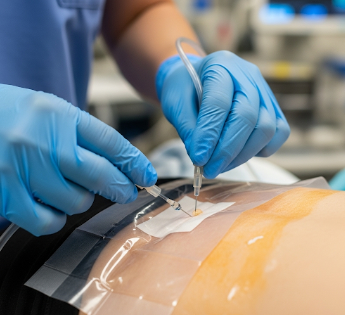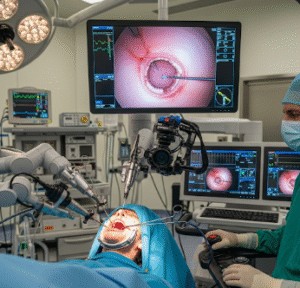What is an Epidural?
An epidural is a medical procedure in which medication is injected into the epidural space surrounding the spinal cord to provide pain relief or anesthesia. It is commonly used for:
💉 Types of Epidural:
✔️ Labor Epidural – Pain relief during childbirth
✔️ Surgical Epidural – Anesthesia for abdominal, thoracic, or orthopedic surgeries
✔️ Chronic Pain Epidural – Management of back, leg, or nerve pain
Mechanism of Action:
➡️ Blocks pain signals from nerves in the lower body
➡️ Provides anesthesia or analgesia without full loss of consciousness
➡️ Can be continuous or single-dose depending on procedure or pain management need
In Korea, epidurals are widely used in hospitals, maternity centers, and pain management clinics with highly trained anesthesiologists and modern equipment ensuring accuracy, safety, and patient comfort.
Why It’s Done
Epidurals are used to provide targeted pain relief, reduce stress responses, and improve outcomes in various settings:
✔️ Pain management during labor – Allows women to have a controlled, less painful delivery
✔️ Surgical anesthesia – For lower abdominal, pelvic, and lower limb surgeries
✔️ Chronic pain relief – For conditions such as sciatica, herniated discs, or spinal stenosis
✔️ Reduce systemic medication needs – Minimizes the need for high-dose opioids and their side effects
Clinical Benefits:
➡️ Effective pain relief → Patients remain awake and comfortable
➡️ Improved surgical conditions → Muscle relaxation and hemodynamic stability
➡️ Faster recovery → Early mobilization post-surgery or labor
➡️ Reduced complications → Avoids general anesthesia side effects when possible
In Korea, epidural use is standard practice in maternity care, particularly in urban hospitals and specialized birthing centers, offering pain-free labor and delivery.
Alternatives
While epidurals are highly effective, alternative pain management options exist:
⭐ Intravenous analgesia – Opioids or non-opioid medications
⭐ Spinal anesthesia – Single-dose anesthesia for shorter procedures
⭐ Regional nerve blocks – Targeted anesthesia for specific areas
⭐ Non-pharmacologic labor pain methods – Breathing techniques, hydrotherapy, acupuncture, or TENS
⭐ Oral or topical analgesics – For mild to moderate pain management
👉 Key Point: Epidurals provide more effective, continuous pain relief compared to most alternatives, especially for labor or major surgeries.
Preparation
Preparation for an epidural involves assessment, planning, and patient education:
🔹 Medical assessment – Review medical history, allergies, medications, and coagulation status
🔹 Informed consent – Discuss procedure, benefits, risks, and alternatives
🔹 Fasting – Usually required for surgical epidurals or labor in some cases
🔹 Positioning – Patient will be asked to sit or lie on the side to expose the spine
⭐ Monitoring equipment – Blood pressure, heart rate, and oxygen saturation are prepared
⭐ IV access – Established for fluid administration if needed
How It’s Done
Epidural administration is a specialized, precise procedure performed by trained anesthesiologists:
- Positioning
✔️ Patient sits upright or lies on the side
✔️ Spine flexed to widen intervertebral spaces - Sterilization and Local Anesthetic
🔹 Skin is cleaned and sterilized
🔹 Small local anesthetic injected to numb the area - Needle and Catheter Insertion
➡️ Epidural needle inserted between vertebrae into the epidural space
➡️ Catheter may be threaded for continuous medication delivery
➡️ Needle removed, leaving catheter in place if required - Medication Administration
✔️ Local anesthetic with or without opioid injected
✔️ Dosage adjusted based on procedure and patient response
Highlights:
✔️ Provides targeted pain relief
✔️ Continuous infusion possible for prolonged procedures or labor
✔️ Patient remains conscious and able to communicate
Recovery / Follow-up
Recovery from an epidural depends on the type and duration:
✔️ Immediate monitoring – Blood pressure, heart rate, and neurological status
✔️ Motor and sensory assessment – Ensures no numbness or weakness persists
✔️ Catheter removal – Done once pain relief is no longer required
✔️ Observation for complications – Typically 1–2 hours post-procedure
⭐ Patients can mobilize as soon as numbness decreases, aiding faster recovery
⭐ Follow-up may include pain diary or consultation for chronic pain management
Complications / Risks
Epidurals are generally safe, but potential risks include:
⚠️ Low blood pressure – Usually managed with fluids and monitoring
⚠️ Headache – Post-dural puncture headache in rare cases
⚠️ Back soreness or bruising – Mild and temporary
⚠️ Nerve injury – Rare, usually temporary numbness or weakness
⚠️ Infection – Extremely rare with sterile technique
⚠️ Allergic reaction – Rare, related to anesthetic medications
➡️ In Korea, strict protocols, sterile techniques, and monitoring minimize the risk of complications.
Treatment Options in Korea
Korean hospitals provide comprehensive epidural services for labor, surgery, and chronic pain:
🏥 Labor Epidural Services – Available in most urban hospitals and birthing centers
🏥 Surgical Epidurals – For orthopedic, abdominal, and gynecological surgeries
🏥 Chronic Pain Epidurals – For back, leg, or nerve pain, sometimes with steroid injections
🏥 Multidisciplinary Pain Management – Anesthesiologists, neurologists, and physiotherapists collaborate
🏥 Advanced Equipment and Techniques – Ultrasound-guided placement, patient-controlled analgesia
Why Korea is a Preferred Destination:
✔️ Highly skilled anesthesiologists – Extensive experience with labor and surgical epidurals
✔️ Modern equipment and monitoring – Safe and effective delivery of anesthesia
✔️ Comprehensive pain management programs – For acute and chronic conditions
✔️ Patient-centered care – Education, comfort, and choice respected
Approximate Costs in Korea:
🔹 Labor Epidural → $200 – $500
🔹 Surgical Epidural → $150 – $400
🔹 Chronic Pain Epidural Injection → $100 – $300 per session
🔹 Hospital consultation and monitoring → $50 – $100
Conclusion
An epidural is a safe, effective, and targeted method for pain relief in labor, surgery, and chronic conditions.
It helps patients:
✔️ Experience effective pain relief while remaining conscious
✔️ Reduce the need for systemic opioids
✔️ Recover faster with early mobilization
✔️ Undergo surgical procedures comfortably and safely
In Korea, patients benefit from:
✔️ Advanced anesthesia techniques
✔️ Expert anesthesiologists and multidisciplinary teams
✔️ Comprehensive services for labor, surgery, and chronic pain
✔️ Patient-centered, safe, and monitored care
👉 Key Message: Epidurals in Korea provide efficient, safe, and personalized pain management, improving comfort, recovery, and overall outcomes for patients across multiple medical settings.













